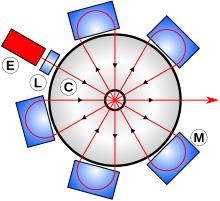Rhodotron
The rhodotron (from the Greek rhodon for rose, because of the rosette-like particle path) is a type of electron accelerator . It is particularly suitable for industrial applications in which high continuous wave beam currents of the order of 10 mA are required with electron energies of the order of 10 MeV , corresponding to a power of the order of 100 kW .
concept
Space charge problem in conventional high frequency accelerating elements
If electrons are to be accelerated in a high current with cylinder-symmetrical cavity resonators or with a traveling wave accelerator, this is hindered by space charge effects. This is especially true when the beam is repeatedly guided through the same acceleration path as in the synchrotron or microtron . The acceleration elements mentioned work with the TM 010 or TM 01 vibration mode. In these modes there is a magnetic field everywhere outside the cylinder axis, which would deflect the particles undesirably; To avoid this, the particle trajectories of the individual passages must all run together on the same axis.
Coaxial resonator
The space charge problem can be reduced by using a coaxial resonator for acceleration . This is a vacuum coaxial line short-circuited at both ends and operated in TEM mode . If it is fed with a high-frequency voltage whose half wavelength is equal to the cable length, a standing wave is formed . Their electric field is directed radially and has its maximum in the median plane between the two ends; the magnetic field is azimuthal, ie directed “around the axis” and is zero in the center plane.
In the rhodotron, the electron beam is injected radially into the center plane of such a resonator and, after passing through externally attached deflection magnets, is returned so that it passes through the center plane several times along different diameters. Only in a very small crossing area in the middle do all the track sections meet.
So that acceleration takes place during the entire resonator crossing , the electric field must reverse when the particle packet crosses the inner conductor. Before and after the center passage, the electrons should be in the field for as large a part of the respective half-cycle of the alternating voltage as possible. The flight time to the next mid-point must be equal to the full period (or an integer multiple of it) so that the particle packet arrives again in the correct phase. The electrons have almost the speed of light , so they cover a distance almost equal to the wavelength during one period. Since part of the path runs in the deflection magnet, these conditions mean that the diameter of the resonator must be slightly smaller than the wavelength.
description
Existing rhodotrons operate at frequencies close to 100 MHz (megahertz), the upper end of the VHF radio frequency band , because amplifier tubes of the required high power are commercially available for this. The resonator made of sheet copper or copper-plated sheet steel is a standing cylinder with a base, cover and tubular inner conductor. Since the wavelength is 3 m at 100 MHz, the resonator is about 1.5 m high. With a diameter of the outer conductor of around 2 m, an energy gain of 1 MeV per passage can be achieved.
The electron gun is operated in a pulsed manner at the acceleration frequency. It supplies electrons with an energy of 50 keV with a peak current of up to 150 mA. A solenoid as a magnetic lens adjusts the emittance of the beam to the resonator. The focusing of the beam during acceleration is achieved by a suitable shape of the pole pieces of the deflection magnets.
The Belgian company Ion Beam Applications offers rhodotrons in several power levels .
Individual evidence
- ↑ a b c Jacques Pottier: A new type of rf electron accelerator: The rhodotron . In: Nuclear Instruments and Methods in Physics Research Section B: Beam Interactions with Materials and Atoms . 40-41, Part 2, April 2, 1989, pp. 943-945 , doi : 10.1016 / 0168-583X (89) 90512-0 .
- ^ A b Y. Jongen, M. Abs, JM Capdevila, D. Defrise, F. Genin, A. NGuyen: The Rhodotron, a new high-energy, high-power, CW electron accelerator . In: Nuclear Instruments and Methods in Physics Research Section B: Beam Interactions with Materials and Atoms . tape 89 , no. 1-4 , May 1, 1994, pp. 60-64 , doi : 10.1016 / 0168-583X (94) 95146-2 .
- ^ Yves Jongen: Rhodotron accelerators for industrial electron-beam processing: a progress report . In: EPAC96. Fifth European Particle Accelerator Conference, Sitges, Spain (June 10-14, 1996) . 1997 ( PDF [accessed on January 24, 2015] hdl : 2078.1 / 68206 ).
- ↑ IBA company website on the Rhodotron

